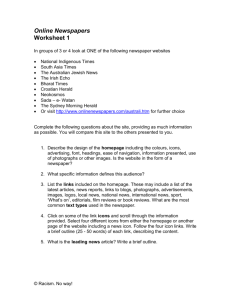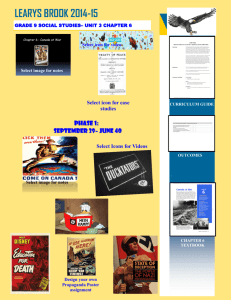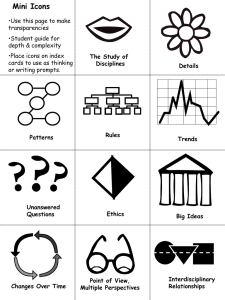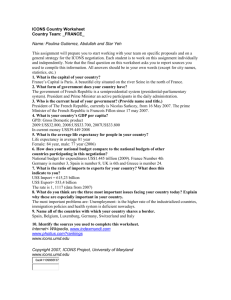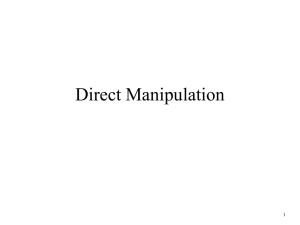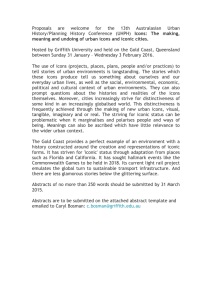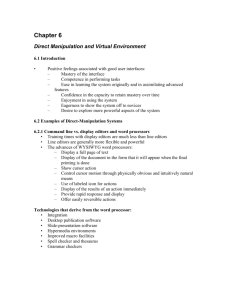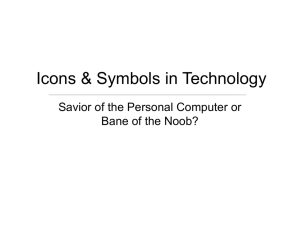Human-Computer Interaction
advertisement
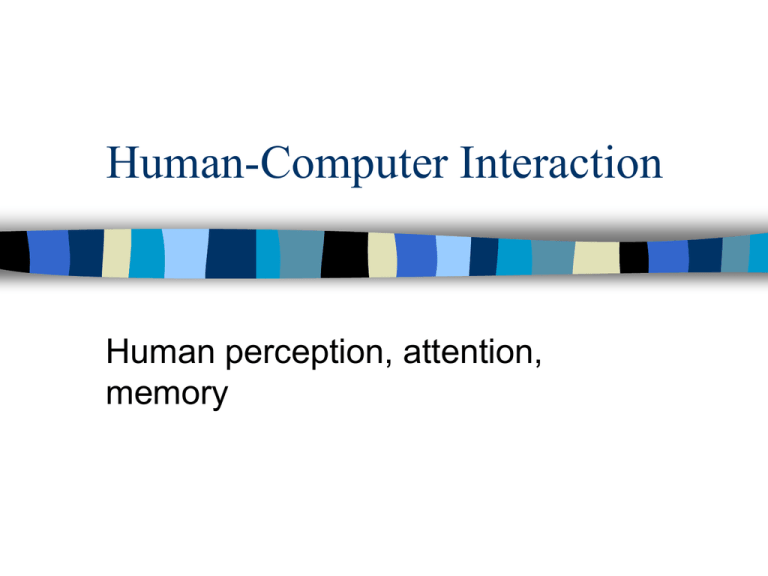
Human-Computer Interaction Human perception, attention, memory Visual perception Humans capable of obtaining information from displays varying considerably in size and other features but not uniformly across the spectrum nor at all speeds Theories Constructive theorists: the process of seeing is active; view of the world constructed from info in environment and previously stored knowledge Ecological theorists: perception involves the process of picking up info from the environment; doesn’t require construction or elaboration Visual perception How long did it take to recognize the Dalmation? Only after you knew what you were looking for? After recognizing the Dalmation, what else could you see? Interpretation of the scene is possible because we know what Dalmations, trees, etc. look like -- active construction of the image. Constructivist approach Perception involves intervention of representations and memories not like the image a camera would produce -instead, a model that is transformed, enhanced, distorted, and portions discarded ability to perceive objects on a screen is a result of prior knowledge and expectations + image on retina Effect of context on perception When presented with ambiguous stimuli, our knowledge of the world helps us to make sense of it -- same with ambiguous info on computer screen Constructive process also involves decomposing images into recognizable entities: figure and background Gestalt psychologists Believed that our ability to interpret the meaning of scenes and objects is based on innate human laws of organization Gestalt laws of perceptual organization Proximity - dots appear as groups rather than a random cluster of elements Similarity - tendency for elements of same shape or color to be seen as belonging together Closure - missing parts of the figure are filled in to complete it, so that it appears as a whole circle Continuity - the stimulus appears to be made of two lines of dots, traversing each other, rather than a random set of dots Symmetry - regions bounded by symmetrical borders tend to perceived as coherent figures Figure and Ground Figure – similar elements Ground – contrasting, dissimilar elements Figure and Ground White horses Black horses? Escher art often plays with figure/ground Camouflage Figure so similar to ground that it tends to disappear Similarity Things that share visual characteristics like shape, size, color, texture, orientation seen as belonging together Similarity Larger circles seen as belonging together Proximity/Contiguity Things that are closer are seen as belonging together See vertical vs. horizontal lines See two groups of two Continuity Tend to see figures as continuous Closure Tend to see complete figures, even when part of info is missing Closure What do you see? Area The smaller of two overlapping figures is perceived as figure while larger is perceived as ground Area Can reverse effect with shading Symmetry Whole figure is perceived rather than individual parts What do you see? Ecological approach Perception is a direct process; information is detected not constructed humans will actively engage in activities that provide the necessary info to achieve goals affordances: our understanding of the behavior of a system is what is afforded or permitted by the system – obvious -> easy to interact with – ambiguous -> more mistakes – examples: door handles, scroll bars Graphical Representation at the Interface Use realistic graphics in interface – effective – too expensive – often unnecessary Methods – graphical modeling – graphical coding Graphical modeling Represent 3D objects on 2D surface, requires depth cues – size - larger of two otherwise identical objects appears closer than smaller one – interposition - blocked object perceived as behind blocking object – contrast, clarity, brightness - sharper and more distinct indicates near, duller appear far – shadow - cues re: relative position – texture - as apparent distance increases texture of detailed surface becomes less grainy Depth cues, continued Motion parallax– move head side to side, objects displaced at different rates – on screen: move camera so image on screen moves, following rules of motion parallax stereoscopic – two images, one per eye, shown from slightly different angles (used in VR head-mounted displays) Solid modeling v. wireframe Solid modeling: color and shading used to achieve high-fidelity – more info about from, shape, surface – compute-intensive Wireframe - schematic line drawings – good for showing internal structure – cheaper to compute Applications of 3D Design of buildings, cars, aircraft virtual reality molecular modeling Graphical coding Symbols, colors, other attributes represent state of system Examples: – – – – – – reverse video to represent current status of files abstract shapes to represent different objects color represents options alphanumerics represent data object size of icon maps to file size wastebin image for deletion capability Coding Methods Alphanumerics – unlimited number of codes – versatile; self-evident meaning; location time often higher than for graphic coding Shapes – 10-20 codes – effective if code matches object or operation represented Coding Methods Color – 4-11 – attractive, efficient; excessive use is confusing – limited value for the color-blind Line angle – 8-11 – good in special cases (e.g., wind direction) Line length – 3-4 – good, but can clutter display if many codes shown Coding Methods Line width – 2-3 – good Line style – 5-9 – good Object size – 3-5 – fair; can take up considerable space – location time longer than for shape and color Coding Methods Brightness – 2-4 – fatigue can result w/ poor screen contrast Blink – 2-4 – good for getting attention; should be suppressible afterward; annoying if overused; limit to small fields Coding Methods Reverse video – no data – effective for making data stand out; can emphasize flicker Underlining – no data – useful, but can reduce text legibility Combinations of codes – unlimited – can reinforce coding; complex combos confusing Graphical coding for quantitative data Advantage is that graphs make it easier to perceive – relationships between multidimensional data – trends in data that is constantly changing – defects in patterns of real-time data Color coding Good for structuring info and creating pleasing look excessive use can lead to “color pollution” experiments performed to determine effectiveness of using color coding in cognitive tasks, emphasis on identifying target stimuli from crowded displays, categorizing, memorizing Results Segmentation – color good for dividing display into regions; areas that “belong together” should have the same color Amount of color – too many colors increases search times; use conservatively Task demands – color most powerful for search tasks, less useful for categorization and memorization tasks Experience of user – in search tasks color benefits inexperienced more Guidelines for using color to distinguish layers to make items of interest stand out use dark or dim backgrounds Color and text White text w/out intervening space is difficult to read; color can help if used to separate boundaries of words red and blue words appear to lie in different planes -- can be used to attract attention, or may cause problems (color stereoscopy) Color v. monochrome Alphanumeric coding superior to color coding for identification tasks (Christ, ‘75) No difference in response time or accuracy for ID of objects based on b&w line drawing v. full color photos Color 8% of male population is color-blind redundant coding suggested -- both color and some other feature – e.g., traffic lights -- both color and order Good visual representations: Classic example: Minard’s map of Napoleon’s march on Moscow Icons Small pictorial images used to represent system objects, applications, utilities, commands Assumption: icons can reduce complexity of the system, making it easier to learn and use Problem: distinguishing among a large number of icons – Solution -- icon to show type; color shape, or size to distinguish among elements of same type Icons: Pros Recognition v. recall = low memory load International symbols Compact Support direct manipulation Icons: Cons Arbitrary icons not intuitive Designing good icons is an art Limited number can be recalled Context dependent Meaning of icons Mapping from computer icon to function it represents is often arbitrary, has to be learned Design principles: icons Appropriate for context of use Appropriate for task Iconic representations A) resemblance – depict the underlying concept through analogous image (rocks falling) B) exemplar – - a typical example (silverware -> restaurant) C) symbolic – conveys underlying meaning more abstract than image (cracked wine glass > fragile) D) arbitrary – bear no relation to underlying concept Iconic representations Concrete icons more easily interpreted than abstract ones Thus: object icons easier than action icons Evaluating icons Graphic legibility – what objects does the icon show, graphic resolution? Interpretation accuracy – does the icon suggest the right concept? Interpretation strength – does the icon suggest the right concept first? Contrast set distinction – does each icon stand out from the family? Contrast set inclusion – do the icons in a family group together? Also - is the icon aesthetically pleasing? Icons: add’l considerations Icons may be used to represent multiple states of an object – Mailbox empty/full – Agent waiting/busy Need to test icons in each state, against whole family Icon screen design issues Allow for different icon states Avoid jaggy lines Be aware of background patterns Stick to platform’s graphical style Design for lowest screen quality Color: subtle, small palette, redundancy, Icons: example 1 packing crate icons Icons: example2 Desktop icons Representational Forms Concrete objects abstract symbols(lines, circles, dots, arrows) combination most meaningful icons use a combined form of representation, provided users are familiar with conventions depicted by abstract symbols Function Text better than graphics for retrieving verbal information Icons better when: – recognition plays a major part in task • select type of restaurant, method of payment – tasks require manipulative operations • drawing, painting Underlying concept Concrete objects easiest to represent warnings, operations more difficult Combination Users less likely to forget icon meaning than to forget name of command redundancy often used – pro: text makes meaning clear; icon easier to remember – con: more screen space Animated icons Effectively portray complex and abstract processes must focus on key aspects of function bad ones confusing selection a problem mode (animation v selection) a problem Your job now … Break into groups of 3-4 Group A: – Design icons to represent: • • • • – – – – Move a block of text Copy a block of text View text in temp storage Insert a block of text Sketch 3 solutions for each – use color if you can Evaluate your solutions Revise Demonstrate Group B Design signage for new high-speed train that will travel Europe-Russia-Asia Signs for: – Baggage – Sleeping cars – Diapering station – Dining Same procedure as for group A. Attention and Memory Constraints “Everyone knows what attention is. It is the taking possession of mind, in clear and vivid form, of one out of what seem several simultaneously possible objects or trains of thought … It requires withdrawal from some things in order to deal effectively with others.” – W. James, 1890 “cocktail party phenomenon” Ability to focus on one activity, while tuning out others can be distracted from one task if attention called to another Attention Focused attention -- ability to attend to one event from a mass of competing stimuli Divided attention -- attempt to attend to more than one thing at a time Focusing attention at the interface Structuring information – structure interface so it is easy to navigate through – “right amount” of info per screen – grouped and ordered into meaningful parts (See Gestalt laws of perceptual grouping) Exercise: structuring information Version 1 Version 2 Examples of structured info DC metro map Techniques for guiding attention Spatial and temporal cues color alerting -- flashing, reverse video, auditory warnings… windowing Note that: Info needing immediate attention should be displayed in a prominent place less urgent info to less prominent place, but in a specific location info needed intermittently shouldn’t be displayed unless requested Multitasking and interruptions People are interrupted while working, and often carry out several tasks at once… Primary v. secondary task, suspend and resume Problem: resume from wrong point Common solution: cognitive aid – lists, post-its, coffee cup on flap handle Cognitive Aids Goal: design system to provide information systematically about status of an activity what has been done, what needs to be done Exercise - Stroop Effect Example Cognitive Processes Automatic – fast; demand minimal attention; don’t interfere with other activities – unavailable to consciousness – hard to change once learned Controlled – limited capacity; require attention and conscious control – easier to change Effect on UI design decisions Interactions that have become automatic are difficult to unlearn Consistency across versions, tools can help avoid this problem Memory constraints Some things easy to learn; others hard Levels of processing theory: – extent to which new material can be remembered depends on its meaningfulness – analysis of stimulus ranges from shallow - deep – meaningfulness determines depth of analysis which affects how well remembered Meaningfulness – familiarity – imagery Effect on UI design decisions Items that need to be remembered should be as meaningful as possible Problem: familiar names need to make sense in computer domain Computer science: names often abstract or arbitrary Unix commands Cat grep lint mv pr lpr Paper of interest Donald A. Norman, The trouble with UNIX: the user interface is horrid. Datamation, 27(12), 139-50, November 1981. -- extended critique of UNIX commands
